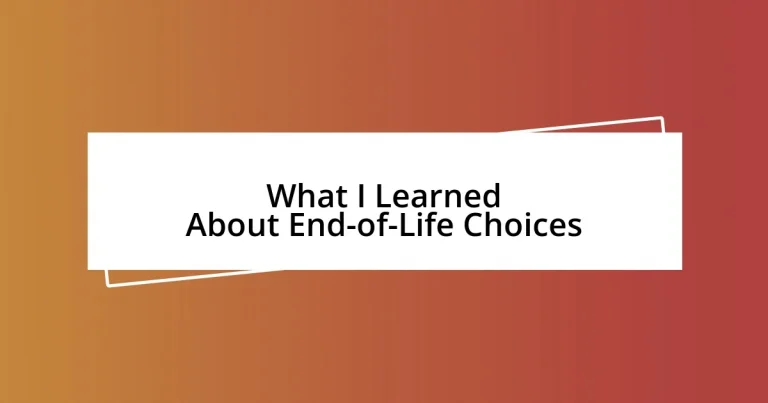Key takeaways:
- Open discussions about end-of-life preferences enhance understanding, reduce anxiety, and strengthen family connections.
- Advance directives play a crucial role in honoring individual wishes, providing clarity and reducing emotional chaos during critical moments.
- Palliative care focuses on improving quality of life and emotional well-being, emphasizing the importance of compassionate support in end-of-life planning.
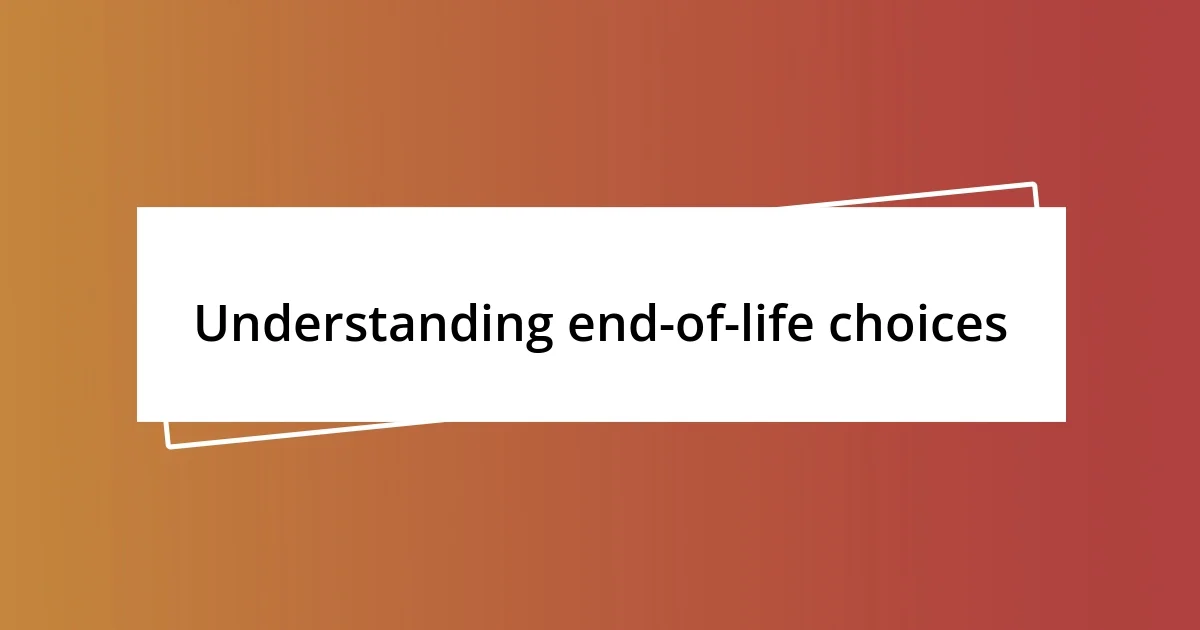
Understanding end-of-life choices
Understanding end-of-life choices is a deeply personal journey that often reflects our values and beliefs. In my experience, it can be profoundly moving to witness how families come together, grappling with such weighty decisions. Have you ever considered how love shapes these choices? It’s astonishing how our connections can guide us in navigating this complex landscape.
When I faced the possibility of losing a loved one, I realized how crucial it is to discuss preferences openly. We often shy away from these conversations, thinking they’re morbid, but I found that talking about end-of-life options fosters understanding and peace. Sharing those moments not only honors one’s wishes but also creates a space for healing for everyone involved.
Ultimately, embracing end-of-life choices can empower both individuals and their families. I remember a poignant discussion with a close friend about their desire for a peaceful passing at home. It sparked a dialogue that helped me appreciate the importance of tailoring end-of-life plans to what truly matters to us. Isn’t it comforting to know that we can assert our preferences, even in our final moments?
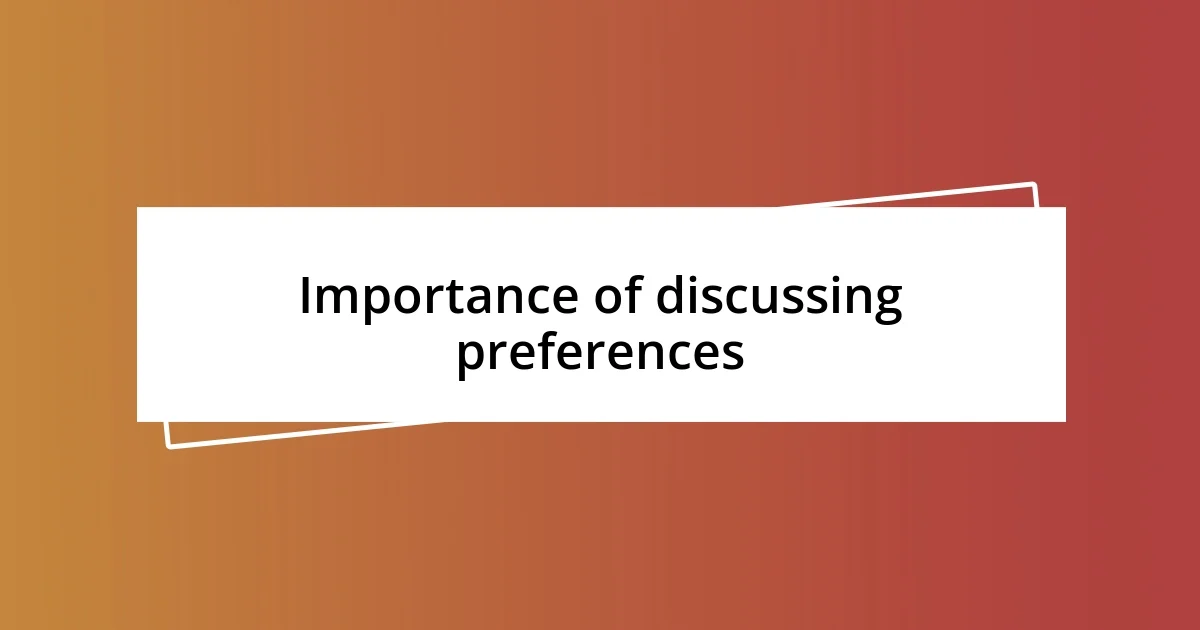
Importance of discussing preferences
Discussing preferences related to end-of-life choices is vital for ensuring that our wishes are respected. I remember a time when I hesitated to bring this up with my grandmother. Eventually, I mustered the courage to ask her about her desires, and it turned into a beautiful conversation that brought us closer. That dialogue helped me understand her values, which is a gift that I cherish to this day.
Having these discussions can significantly reduce the anxiety and uncertainty that families often face when making decisions on behalf of a loved one. I vividly recall sitting with a friend as she navigated her father’s illness. They had already talked about his wishes, which made it easier for her to advocate for him when it mattered most. This experience underscored the peace that comes from knowing someone’s preferences; it alleviated the burden of decision-making during a challenging time.
Moreover, discussing end-of-life preferences fosters deeper connections among family members. I witnessed this firsthand when my sister and I decided to engage our parents in these conversations. It transformed our family dynamic—the open sharing of thoughts and values created an atmosphere of trust and understanding. It’s just like opening a window in a stuffy room. Suddenly, it feels brighter and more manageable.
| Aspect | Consequence |
|---|---|
| Open Communication | Reduces misunderstandings and anxiety during difficult times. |
| Clarity of Wishes | Ensures that preferences are clear and respected. |
| Emotional Connection | Strengthens relationships through shared understanding. |
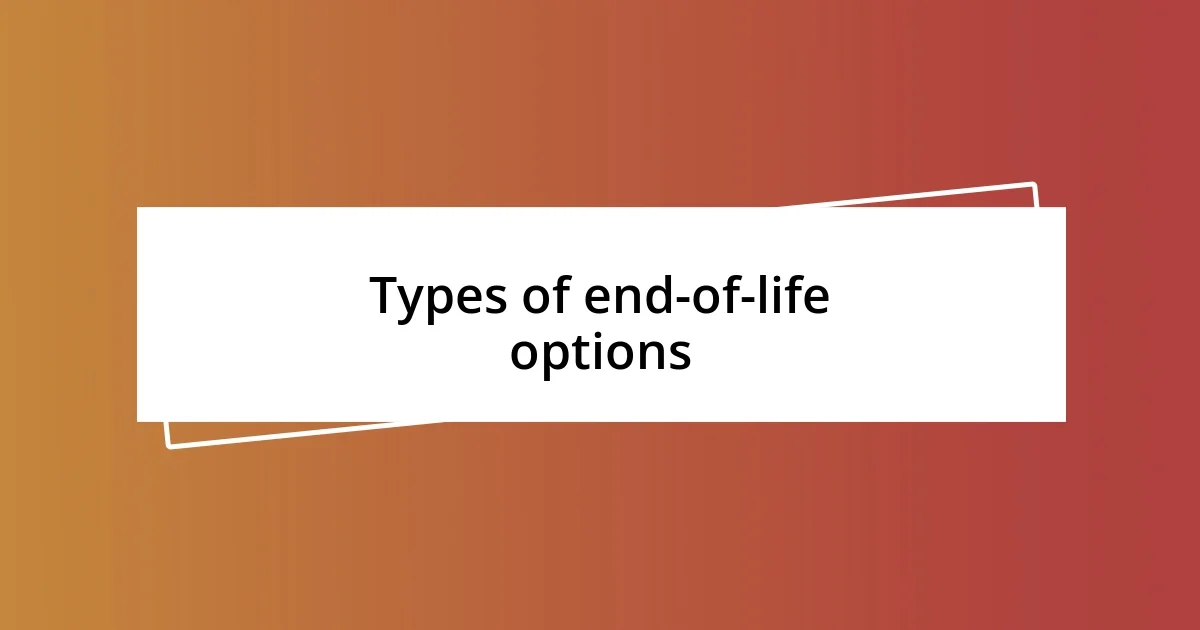
Types of end-of-life options
When it comes to end-of-life options, I’ve discovered that there are several paths individuals can choose, each reflecting a unique set of values and circumstances. For example, I had a friend whose father chose hospice care, embracing a comfortable and supportive environment in his final days. This choice emphasized quality over quantity of life, allowing for a peaceful goodbye at home, surrounded by his loved ones.
Here’s a brief overview of some common end-of-life options:
- Hospice Care: Focuses on comfort and quality of life rather than curative treatments, typically for those facing terminal illnesses.
- Palliative Care: Aimed at reducing suffering and improving the quality of life, it can be provided alongside curative treatment.
- Advance Directives: Legal documents that outline a person’s preferences for medical treatment if they are unable to communicate their wishes.
- Do Not Resuscitate (DNR) Orders: A specific directive indicating that a person does not want to receive CPR or other life-saving measures in the event of cardiac arrest.
- Euthanasia and Physician-Assisted Suicide: Options that allow individuals to end their lives intentionally under specific conditions, highlighting the importance of autonomy in suffering.
I remember visiting my aunt during her final days. She had opted for palliative care, and while her body was frail, there was a remarkable sense of peace in that room. The staff treated her with kindness and dignity, consistently prioritizing her comfort. I realized that every choice stems from a personal narrative; it’s not just about the options but the stories behind them that shape these critical decisions.
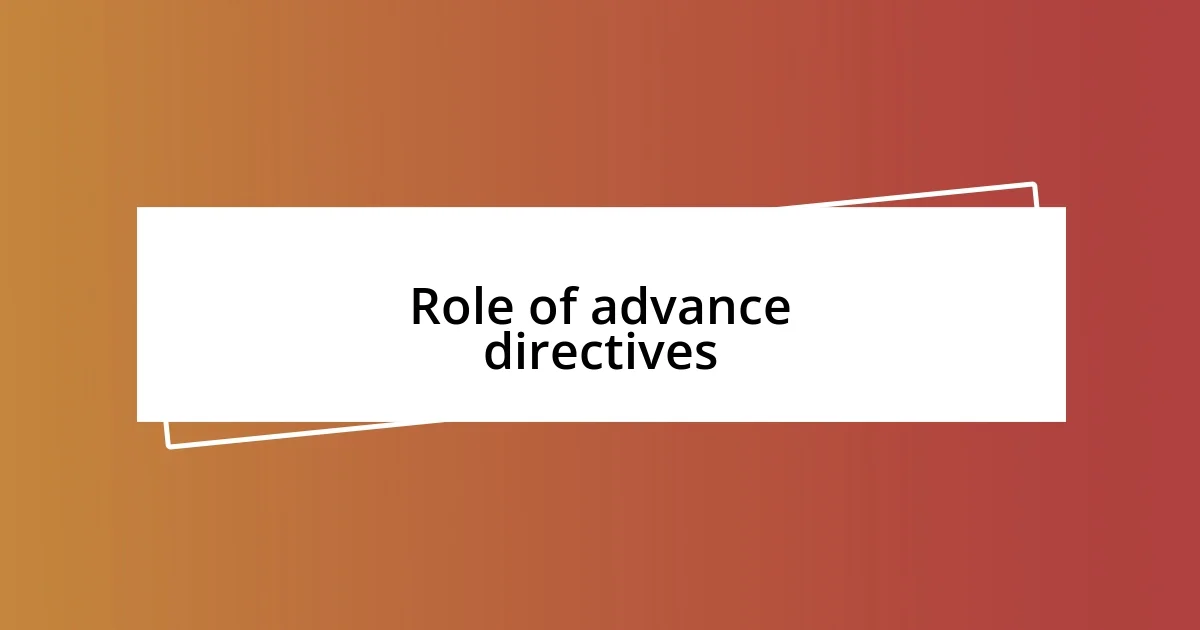
Role of advance directives
Advance directives play a crucial role in ensuring that individual preferences for medical treatment are honored, even when a person is unable to voice them. I once helped a close friend navigate the process of completing her mother’s advance directive. The emotional weight of that task was immense, yet it felt empowering to clarify her mom’s wishes in a legal format. It served as a reminder that these directives aren’t just documents; they’re reflections of our values, wishes, and the dignity we desire in our final moments.
I recall a poignant moment when my neighbor chose to enact her advance directive during her battle with cancer. As her condition worsened, she accessed the document we had completed together months earlier. I watched as her family rallied around her, supported by the clarity of her wishes. It brought me to tears, realizing how such a simple piece of paper had transformed a chaotic situation into an opportunity for her family to honor her choices with grace and love. Isn’t it comforting to know that we have the power to guide decisions, even from a place of vulnerability?
When I think about advance directives, I often wonder how many people truly understand their significance. Having experienced both sides, I can confidently say that they facilitate conversations that may otherwise remain unspoken. They define care, promote trust among families, and ultimately, grant everyone involved a tangible sense of security. The clarity they provide can diminish fears around the unknown—a gift that resonates long after the difficult moments pass.
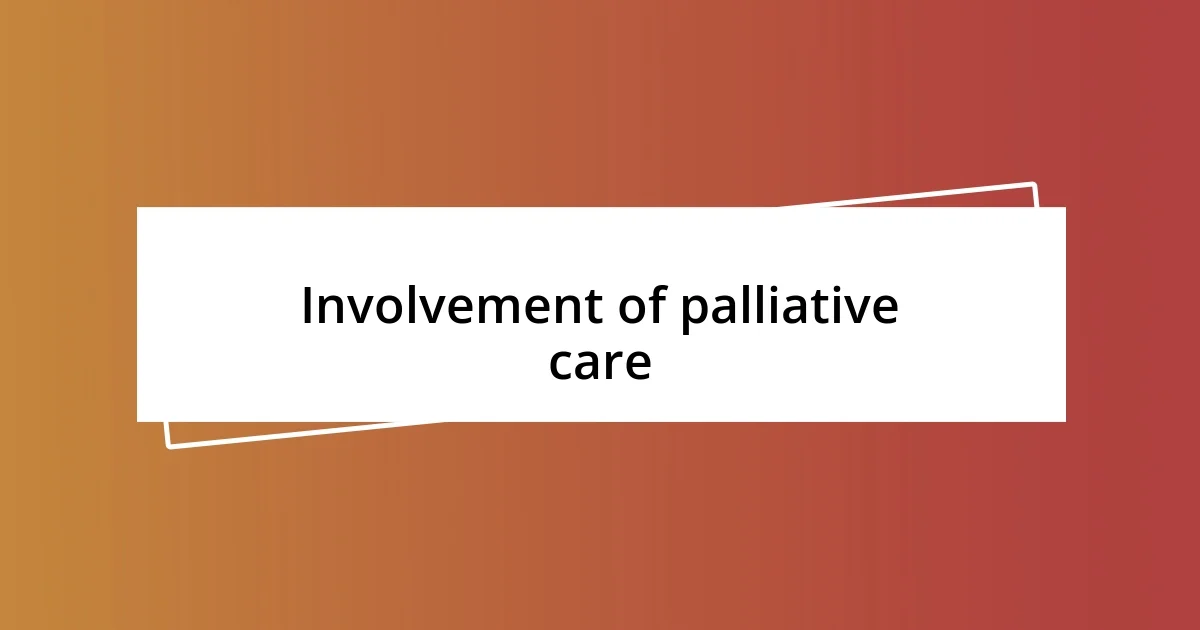
Involvement of palliative care
When I reflect on my experiences with palliative care, I realize how transformative it can be. I once attended a workshop on palliative care options, where I heard stories from professionals who genuinely understood the patient experience. Their dedication to alleviating pain and improving life quality resonated deeply with me—it’s not just about extending life; it’s about making every moment count. How often do we think about that when faced with health crises?
During my aunt’s time in a palliative care unit, I noticed that the focus was on more than just her physical comfort. The team encouraged her to share her life stories, ensuring she felt heard and valued. It struck me how this holistic approach provided emotional support for her and her family. After all, aren’t we all craving connection, especially during vulnerable moments? This experience showed me that palliative care is about creating a safe space where dignity and compassion thrive—they matter as much as any medical treatment.
In conversations with friends about the role of palliative care, I often mention the peace it can bring in chaotic times. I once shared tea with a friend whose mother was in palliative care, and she expressed profound gratitude for the team’s gentle approach. She said that instead of focusing solely on the illness, they celebrated her mother’s life, emphasizing the importance of emotional well-being. This connection made me reconsider how we view end-of-life care: perhaps our perceptions need to shift toward embracing these services as essential supports rather than mere options. Wouldn’t we all benefit from having that same kind of compassionate support when faced with life-altering decisions?
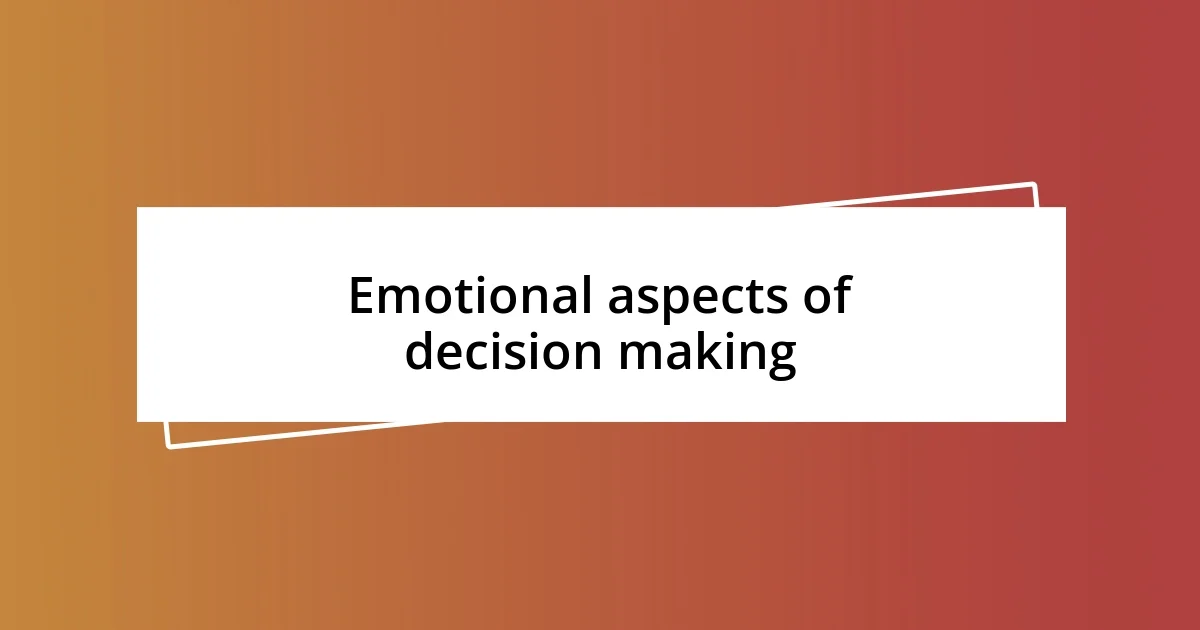
Emotional aspects of decision making
One of the most surprising emotional aspects of decision-making during end-of-life choices is the profound sense of grief that can accompany these decisions, even before a loss occurs. I recall sitting by my father’s bedside after his diagnosis, grappling with the choices before us. The weight of that moment was overwhelming; the potential for loss hung in the air like an unspoken truth. I found myself questioning everything: Was I honoring his preferences? Could I handle the burden of these choices? It became clear that navigating these emotions is as critical as choosing the right medical options.
As I sat with my family, I noticed how different individuals managed their feelings around decision-making. Some felt a sense of relief in discussing end-of-life plans, while others struggled with denial, attempting to shield themselves from the reality of what was happening. This divergence in emotional responses reminded me that decision-making is not a one-size-fits-all process—it’s deeply personal. How often do we reflect on the emotional landscape that surrounds such discussions? I learned that acknowledging each person’s feelings is vital in creating a supportive environment. It encourages open dialogue, making it easier to navigate the complexity of emotions involved.
Reflecting on my experiences, I truly believe that emotional clarity can illuminate decision-making. I remember a moment when my friend chose to share her feelings about her terminal diagnosis openly with her family. Initially, it was painful and raw; however, once they all embraced the conversation, the atmosphere shifted remarkably. They found strength in vulnerability, ultimately leading to decisions made with a sense of unity and understanding. In moments like these, I often wonder: how transformative could it be for others to harness that emotional energy in a constructive way? Learning to embrace emotions as valid aspects of decision-making has taught me that it’s not just about the choices themselves but how those choices can echo with meaning throughout our lives.
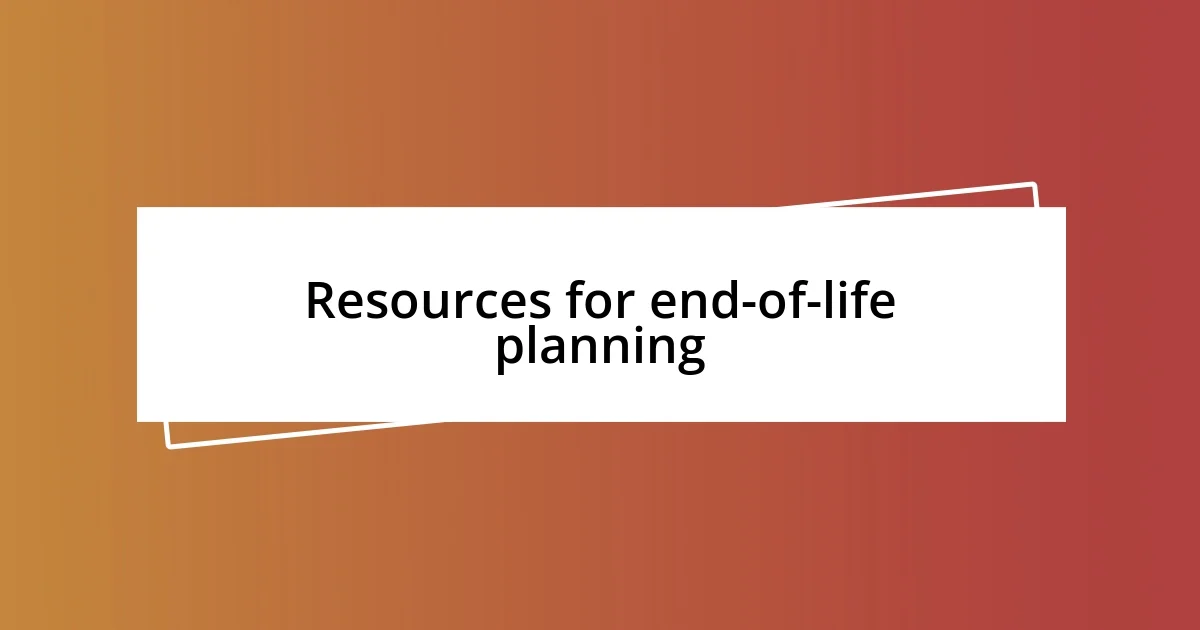
Resources for end-of-life planning
Finding reliable resources for end-of-life planning is crucial, and I’ve discovered several that stand out. One particularly helpful tool is the website of the National Hospice and Palliative Care Organization, which offers guides on advance care planning and lists local hospice services. I remember scrolling through their resources and feeling a sense of relief; everything I needed was just a click away. Have you ever felt overwhelmed by choices, only to find a resource that makes everything clearer?
Another valuable resource is local community workshops on advanced directives and palliative care options. I attended one hosted by a local health care system, and it turned into a remarkable opportunity to connect with others facing similar situations. We shared our stories, and it struck me how these gatherings can transform individual experiences into collective support. I couldn’t help but think: how often do we miss out on these communal strengths when we don’t seek out or participate in local resources?
Additionally, consider consulting with a financial adviser who specializes in end-of-life issues. My friend did this recently when preparing her estate, and she found insights that not only eased her worries but also fostered a sense of empowerment over her decisions. In those moments, it became clear to me that tapping into expertise can lighten the emotional load significantly. Have you thought about how professional guidance could reshape your end-of-life planning approach?











